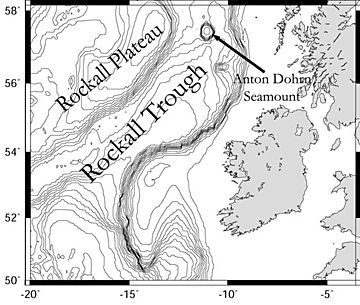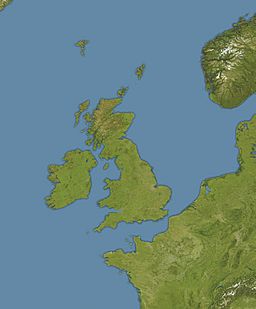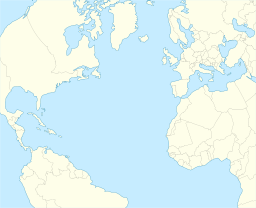Anton Dohrn Seamount facts for kids
Quick facts for kids Anton Dohrn Seamount |
|
|---|---|
 |
|
| Summit depth | 600 metres |
| Height | 1,500 m |
| Location | |
| Location | North Atlantic Ocean |
| Coordinates | 57°30′N 11°00′W / 57.500°N 11.000°W |
| Country | United Kingdom (EEZ) |
| Geology | |
| Type | Guyot |
| Last eruption | ~40 million years |
The Anton Dohrn Seamount is a special kind of underwater mountain called a guyot. It is located in the Rockall Trough in the northeast Atlantic Ocean. This huge underwater peak is about 1.8 kilometres (1.1 mi) tall.
Its top is flat, but it has tall, pointy rocks called pinnacles. One of these pinnacles reaches up to 530 metres (1,740 ft) below the ocean surface. The sides of the seamount drop steeply into the deep Rockall Trough. A ditch, or moat, surrounds the base of the seamount.
The Anton Dohrn Seamount is actually an old volcano. It was formed by basaltic lava and ash. It first appeared a very long time ago, during the Cretaceous and Paleogene periods. Over millions of years, its top slowly sank below sea level due to natural changes and erosion. Scientists first discovered this amazing seamount in 1958.
Today, the Anton Dohrn Seamount is home to many different sea creatures. It has beautiful reefs made of cold-water corals, sponges, and other unique animals. Sadly, human fishing activities have affected this special place.
Contents
What is the Anton Dohrn Seamount?
The Anton Dohrn Seamount is also known by other names, like Anton Dohrn Kuppe. This name was used on German maps. Sometimes, it's also called Anton Dohrn bank.
It was first found on September 22, 1958. This happened when a survey ship named Gauss was exploring the ocean. Later, in April 1959, another research ship, the FFS Anton Dohrn, explored it more closely.
Where is the Anton Dohrn Seamount located?
The Anton Dohrn Seamount is in the northeast Atlantic Ocean. It is west of Scotland. It sits about halfway between St Kilda and Rockall. This is about 155 kilometres (96 mi) west of St Kilda.
It lies within the Rockall Trough. This is a very deep underwater valley, more than 2,000 metres (6,600 ft) deep. To the north is the Rosemary Bank. The Hebrides Terrace Seamount is to the south. The seamount is part of the United Kingdom's special ocean area, called its exclusive economic zone.
What does the Anton Dohrn Seamount look like?
The Anton Dohrn Seamount is a huge, round guyot. It is about 1.8 kilometres (1.1 mi) high. Its top is flat and measures about 45 kilometres (28 mi) by 40 kilometres (25 mi). Flat-topped seamounts are not common in the North Atlantic.
The shallowest part of the seamount is about 530 metres (1,740 ft) deep. This is a tall, pointy rock called a pinnacle. It sticks up from the main flat top, which is about 600 metres (2,000 ft) deep. A thick layer of sand and mud, about 100 metres (330 ft) deep, covers the flat top. Ocean storms and currents can move this sediment around. There are also other small hills and rocky points on the flat top.
The sides of the Anton Dohrn Seamount are very steep. They drop down to depths of 2,400 metres (7,900 ft). These steep slopes have rocky areas and some gravel. There are also cliffs and ridges, but no deep channels or canyons. Smaller, cone-shaped volcanoes are found on the northwestern slope. A deep ditch, or moat, surrounds the seamount. This moat is about 2,300 metres (7,500 ft) deep. It might have formed from ocean currents eroding the seabed.
How did the Anton Dohrn Seamount form?
The Anton Dohrn Seamount is an ancient volcano. Scientists have studied rocks from the seamount. These rocks show that the volcano was active at different times. It erupted about 70, 62, 47, and 41 million years ago. This means it was active for about 29 million years!
Other volcanoes in the area also had similar bursts of activity. This might be linked to a deep hot spot in the Earth called the Iceland plume. The start of the volcano's activity might have been due to the Earth's crust stretching. This volcanic activity during the Cretaceous period shows that the Atlantic Ocean was already starting to split apart back then. At that time, the Rockall Trough was at least 1 kilometre (0.62 mi) deep.
When the volcano erupted, hot magma sometimes mixed with ocean sediments. This caused explosive eruptions that sent volcanic ash into the air. Some scientists thought this ash might have created special clay layers, called bentonites, found in the British Isles. However, later studies did not fully support this idea.
During the Cretaceous period, the seamount was much taller. It might have even reached 2,000 metres (6,600 ft) above sea level. Over time, it was worn down by erosion. This happened especially during the Paleocene period. The land also slowly sank, which helped lower the seamount. The pointy pinnacles on top might be parts of the volcano's old lava channels that were stronger and resisted erosion. Over millions of years, sediments covered the seamount.
What lives on the Anton Dohrn Seamount?
The Anton Dohrn Seamount is a lively place for sea creatures. Barnacles and brachiopods grow on its top. You can also find echinoderms and corals there. On the sandy or gravelly parts, there are serpulids and sponges. Some scientists think the seamount might even be a nursery for sharks.
Many different types of ecosystems exist on the seamount. These include coral gardens, cold-water coral reefs, and communities of sponges. The Anton Dohrn Seamount was the first place in the United Kingdom where coral gardens were found. These reefs grow on rocks or pebbles. They are often found on the sides of the seamount and on hills on its flat top. This might be because of the ocean currents or because the ground there is good for reefs to grow.
Different corals live at different depths. For example, Lophelia corals are found in shallower waters than Solenosmilia corals. Other corals like antipatharians, small bamboo corals, large gorgonians, and soft corals have also been seen. The cold-water coral cover can become so thick that it completely covers the seabed.
Scientists have used special cameras to explore the seamount. They have seen many animals, including anemones, starfish, glass sponges, sea cucumbers, and sea urchins. They also found various types of fish, squat lobsters, and other creatures.
Seamounts are known for having a lot of different kinds of life. They are like "biodiversity hotspots." Because of this, there are plans to make the Anton Dohrn Seamount a special protected area. The ocean currents around the seamount are complex. They are important for the seamount's ecosystem.
How have humans impacted the seamount?
Sadly, deep water fishing has affected the seamount. Lost fishing gear and marks from fishing nets have been found there. Animals living at the bottom of the seamount have even eaten tiny pieces of microplastic.
To help protect this special area, the Scottish Government made the seamount part of the West of Scotland Marine Protected Area in October 2020. This is an effort to keep the area's amazing sea life safe.



